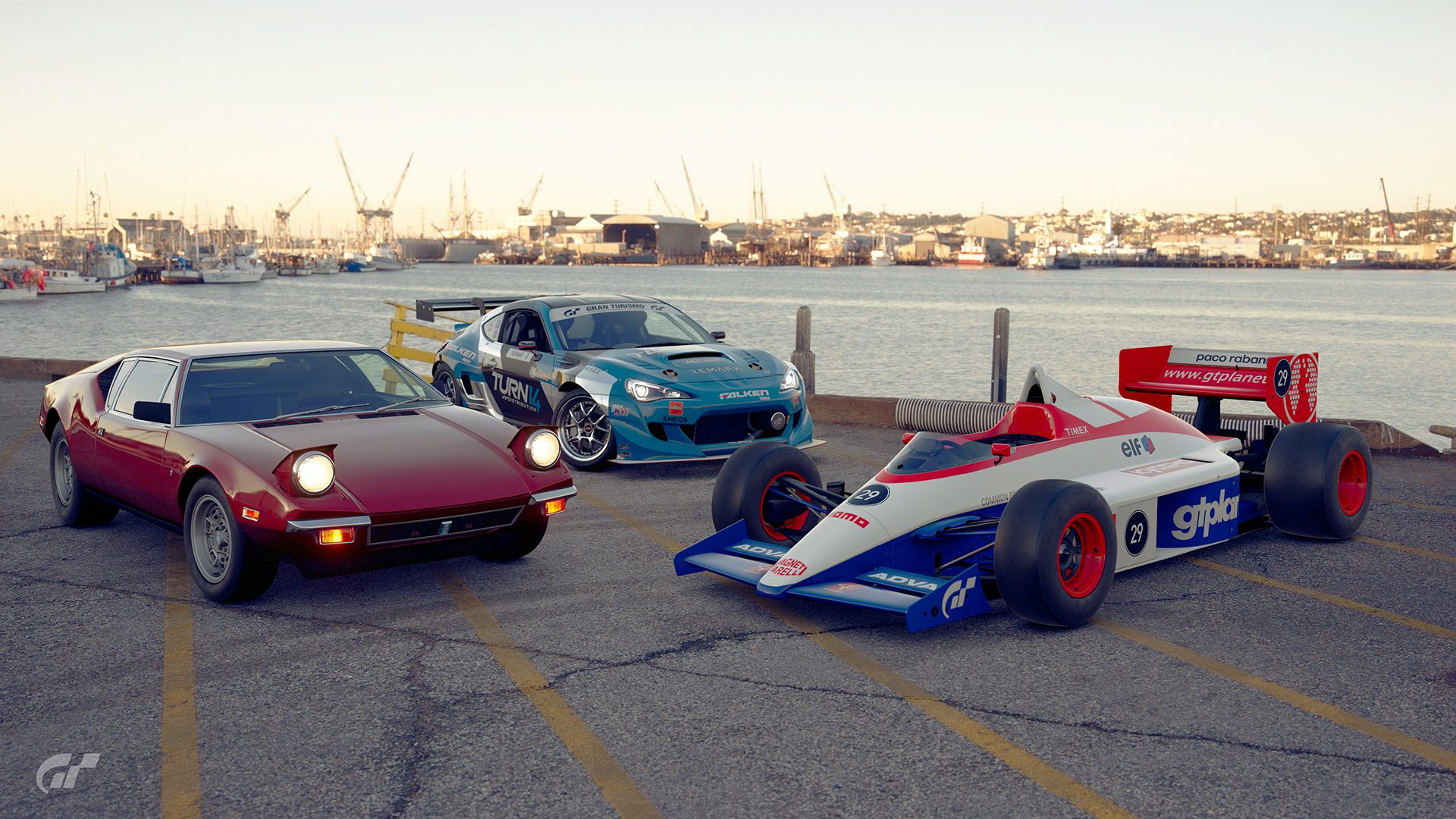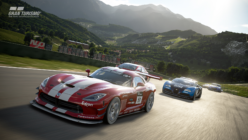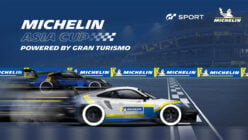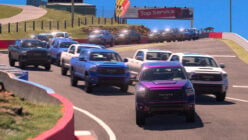Late last month, Polyphony introduced the latest content update for GT Sport. Alongside new layouts for Blue Moon Bay, it brought a dozen new cars for fans to learn, ranging from an early ‘70s rallying icon to a modern drift car and even a fantasy take on one of F1’s most exciting eras.
We’ve taken all of them for a test drive to get a better idea of exactly what they bring to the table.
Like what you see? Stay tuned to GTPlanet’s YouTube channel for more videos like it over the coming days. You can catch the full video below, and our thoughts on each car underneath that.
1972 Alpine A110S
It may be the weakest car of the pack, but the classic Alpine A110 is not a beginner’s car. It shouldn’t be a surprise, really: the A110’s nearly half a century old, and like Porsche’s 911, slings its engine behind the rear axle. That can lead to some… less than ideal lines if you’re not treating it with the right amount of respect.
But the risk is worth the reward. Mind your trail-braking and keep the steering inputs smooth, and the Alpine will gleefully hunt giants with much larger power figures than it.
2017 Alpine A110 Premiere Edition
From old, to new; say hello to the reborn A110. In its first video game appearance, the newest Alpine makes quite a case for itself. In the real world it sits between the Alfa 4C and Porsche Cayman in terms of weight and power. The Alfa’s in GT Sport, and in the N300 class, the Alpine seems like the better choice. It’s planted and feels barely heavier than the Italian. The little 1.8-liter turbo also pumps up a solid wall of torque, though you’d hardly know it given how close-spaced the gears are.
Around Alsace, it makes short work of the hot hatches and classic JDM muscle the game puts it up against. Like any mid-engined car, it can get out of shape very quickly if provoked, but you’d have to be really trying to spin it.
2007 Audi R8 4.2 FSI R tronic
Okay, I’ll be honest, I was very happy to see this, the original V8-engined R8, show up in this bunch. The modern ten-cylinder is cool in its own four-ringed supercar way, but there’s always been a Goldilocks feeling to the original. It’s like a German take on the NSX: sporty enough to worry the establishment, but capable of being driven daily like an A3.
That engine sings around the new infield layout at Blue Moon Bay. Thanks to the four-wheel drive, the R8 almost never puts a foot wrong. It’s an easy car to learn the ropes of N400 with, though experienced drivers may find the eventual understeer a hurdle.
1971 De Tomaso Pantera
The De Tomaso Pantera is a serious — and welcome — surprise in GT Sport. The combo of Italian looks paired with American power is one that’s produced plenty of great cars throughout the years, and the Pantera might be the best.
It’s also a joy to drive. The Pantera is a great example of the tried-and-true slow-in-fast-out approach. The narrow front tires and big mid-mounted V8 mean it will understeer if you’re moving quickly, but slow things down and the car will turn in keenly. Pour it into a corner, feed the throttle in as you wind off lock, and the Pantera will surprise with how natural it feels on track.
1970 Dodge Challenger R/T
Next up is a more traditional approach to American muscle. The Challenger is a boat of a car compared to the Pantera, but you’ll be having so much fun with it you won’t really care.
With a Hemi under the acres of hood up front pushing well over 400hp to the rear wheels, the Challenger can happily keep up with modern cars in straight line. Well, until it very quickly bumps into that rev limiter, that is. That engine isn’t exactly light either, so the car will plow towards the scenery if you go in even a smidgen too hot. Luckily, it’s all too easy to overwhelm the rear tires and get the car pointed in the right direction.
1971 Ford Mustang Mach 1
Coming from the Challenger, the Mach 1 is actually quite similar to drive. There are important differences, however.
Chief amongst them is the sound. The Mach 1’s engine note is higher than the Dodge’s, with more of a sense of urgency. It feels more at home on the track too: watch it do quite well for itself at one of the new Stars & Stripes events with our man Andrew behind the wheel.
Gran Turismo F1500T-A
The car that’s spawned a thousand F1 replica liveries; say hello to the F1500T-A. Ostensibly based on Senna’s Lotus from GT6, this GT-branded car has some slight visual differences, but the same mental nearly 1000hp engine.
I took it around Interlagos and am not ashamed to say I kept the traction control on. Even with it at the default 3 position, the F1500 would pitch sideways coming out of the Senna S at full throttle and well over 100mph. Since it’s running racing tires, you’ll be walking a very fine line when you overstep their grip. It takes a while to learn how much counter steer is too much.
That said, there’s something deeply satisfying about running a high-downforce open-wheeler around here. The five gears are well-spaced, and the shove from that turbo engine doesn’t seem to have an end. I’m afraid of what the 1500 could do to peoples’ Sport Mode rankings, though…
2011 Lamborghini Aventador LP700-4
The Aventador first showed up back in GT5 as one of that game’s first DLC cars. In Sport, it sits in the N700 class, alongside the McLaren 650S and Dodge Charger Hellcat.
Without a doubt, this is the easier car to drive out of that trio. The four-wheel drive helps of course, making the big Lambo feel much smaller than it is. The main blemish on its report is its braking capability: that 700hp V12 is so good at building speed that you need to readjust your braking points to account for that.
2016 Subaru WRX STI Isle of Man Time Attack Car
The only suitable place to take this record-breaking WRX was the ‘Ring. In the real-world, it smashed the four-wheel record at the Isle of Man, but — at least for now — that track is not in GT Sport.
With nearly 600hp and all manner of aero addenda, the mega-Scooby occupies a bit of a no-man’s land in-game. It’s far more of a track car than the other cars at its power level in the N groups, but isn’t quite the full-bore monster of the Gr.3 WRX. Thus, it sits in Gr.X.
But man is it ever fun to toss it around the Green Hell, as Jordan so ably demonstrates.
2017 Subaru Falken Tires / Turn 14 Distribution BRZ
Back at E3 2017, I watched Dai Yoshihara drifting in GT Sport. Fast forward nine months, and the tables have turned; now players can try to emulate Dai’s day job in-game.
Needless to say, there’s a reason he’s the pro. This car is a monster, pure and simple. A big V8 sits up front, pumping more power to the rear wheels than anything else in this pack. A short four-speed gearbox is tailor-made for drifting, keeping the V8 right in its sweet spot as it’s sideways.
It’s all a whole lot of fun, but I’ll be honest: this footage had to be cobbled together from half a dozen runs that went south one way or another. Having this car in the game not only broadens the appeal in GT Sport, but it gives you a newfound appreciation for what talented folks like Dai do in the real world.
1988 Toyota Supra 3.0GT TURBO A
Did we hear you say more Toyotas? Polyphony continues the trend here with not one, but two cars from Japan’s biggest manufacturer. Up first is the third-gen Supra. Here in hyper rare Turbo A form, it boasts slightly less power than its more famous fourth-gen successor, at 266hp.
This generation of Supra was actually my first car ever in Gran Turismo (way back in GT1). With no Grand Valley to revisit, I figured Kyoto had the most similar layout and took it there. The Supra’s a peach around the track; it remains neutral through most corners, and has the right blend of power and grip. It does feel its weight though, so those looking for a more up-on-its-toes feel will want to look elsewhere.
1997 Toyota MR2 GT-S
Say it with me now; roll oversteer. The MR2 is a textbook example of this. Apply power mid-corner, and the weight shifts to the outer rear tire thanks to the soft suspension. Very quickly, the MR2 is bleeding away speed, although it’s not terribly hard to reign back in.
In terms of this dozen of cars, the MR2’s closest partner in crime is the car we started with, the classic Alpine. Both need to be driven the same way; with smooth inputs and the minimum of trail-braking.
Visually, it’s fantastic to have the MR2 in GT Sport. It’s such a slice of the ‘90s, rendered with impeccable detail. Like the Supra last month, the MR2 was last seen as a Standard in the Gran Turismo franchise, and this super-Premium treatment really does it justice. Hats off to Polyphony!
See more articles on GT Sport Game Updates.











